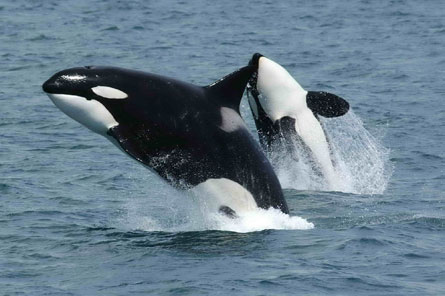- More than 2 years ago
Determining whether animals belong to the same species is not as black and white as you might think.
Take killer whales. Scientists have long debated whether the ocean-dwelling mammals all belong in one species. Now, DNA evidence suggests that killer whales should be classified in at least four species, and maybe more.
Scientists once thought killer whales all belonged to the species Orcinus orca. But as researchers began observing more closely, they discovered that the whales seem to belong to different groups, called ecotypes, with distinct feeding habits and appearances. Killer whales from different ecotypes don’t seem to breed with each other — one criterion for being classified as separate species. So some scientists proposed that killer whales should be grouped into different species.
Early genetic analyses didn’t support that idea. Studies that looked at pieces of mitochondrial DNA, a type of genetic material that can be used as a molecular clock to measure the time since two genetic lineages split, concluded that the various killer whale groups are similar enough to fall into a single species.
But recently, researchers have come to realize that not all molecular clocks keep the same time. The mitochondrial DNA of Adélie penguins, for example, evolves faster than previously thought (SN Online: 11/17/09). Killer whales and other cetaceans, on the other hand, have molecular clocks that tick more slowly than other species’ clocks do, says Phillip Morin, a marine mammal geneticist at the Southwest Fisheries Science Center in La Jolla, Calif.
Morin and colleagues analyzed the mitochondrial genomes of 139 killer whales from around the globe and found that the animals fall into several genetically distinct groups.
“The genetic data show that they are each independently evolving lineages,” Morin says.
There is enough evidence to split off three new killer whale species, Morin and his colleagues propose in a study published online April 22 in Genome Research.
Two of the proposed new species live in the Antarctic. One eats only marine mammals, frequently knocking seals off pack ice to catch its prey. The other pursues fish underneath the pack ice.
A third proposed species lives in the northeastern Pacific and eats a variety of other marine mammals, including seals, sea lions, whales and dolphins. Morin’s team estimates that this group diverged from other killer whales as a separate species about 700,000 years ago. The other groups split off more recently.
“I suspect there’s going to be another four or five species,” says Robin Baird, a cetacean biologist at the Cascadia Research Collective in Olympia, Wash. Killer whales seem to be evolving into new species based on their eating habits, he says, a scenario that is common among birds but extremely rare for mammals.
Not everyone is convinced, however. Mitochondrial DNA is passed from mothers to offspring, so it reflects only one part of a species’s genetic heritage, points out A. Rus Hoelzel of Durham University in England. Going yet another step by analyzing the full DNA makeup of killer whales might reveal genetic exchange between killer whale groups that is not detectable looking exclusively at the maternal lineage. Exchange of genetic information between the groups would indicate that they aren’t separate species.
Morin agrees that a fuller genetic picture of killer whales is called for; he thinks the additional data will validate the finding from mitochondrial DNA that orcas should be classified into a handful of distinct species.
“My gut feeling is that these really are separate species, but the careful scientist in me wants to get a little bit more data … to really nail it down,” he says.







